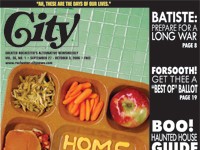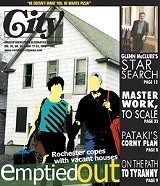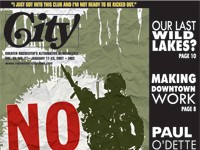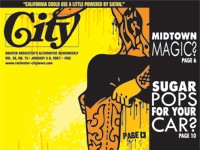[
{
"name": "500x250 Ad",
"insertPoint": "5",
"component": "15667920",
"parentWrapperClass": "",
"requiredCountToDisplay": "1"
}
]
There are almost 100,000 housing units in Rochester. Nearly 11 percent of them are vacant.
It's simple economics, says Julio Vazquez, the city's commissioner of community development. Rochester was built to house more than 300,000 people. It now has fewer than 220,000.
The Rochester area's population has swelled outward --- and the inside has shrunk. We've begun to resemble a badly formed doughnut. And it's not just ugly; it's also expensive.
In memos and speeches, former Mayor Bill Johnson often rattled off the statistics:
• The tax burden in MonroeCounty increased by $512 million between 1987 and 1997, despite little population growth;
• 300 miles of new roads (roughly a round-trip drive from here to Toronto) were constructed in MonroeCounty between 1993 and 2003.
• During that same period, county residents drove 2 miles more per day than a decade prior, or 3,000 miles per family per year. (And with the price of gas now at more than $3 per gallon, you can do the math).
Rochester's vacant houses are more than just a nuisance: They are a threat. These houses are more likely to catch fire than occupied ones. They often attract drugs, prostitution, and violent crime. They diminish property values of other houses in the vicinity. As blight escalates, one vacant house leads to another to another, turning entire neighborhoods into ghost towns.
Vacant houses also bankrupt cities. Municipalities have to allocate additional resources to fight arson and crime. Demolitions cost thousands of dollars. These costs are then tacked onto a city budget diminished by a shrinking property tax base.
"Evidence shows that vacant properties are an expense that local governments simply cannot afford --- and that expense grows with every year a property remains vacant or abandoned," wrote researchers with the National Vacant Properties Campaign.
When John Kohut was 5, his family moved to northeast Rochester from the Ukraine. Hudson Avenue, says Kohut --- now the owner of Four Brothers Tavern on Hudson --- was like a mini Eastern Europe. Churches, grocery stores, and schools all centered around life as it was in the old world. Hudson Avenue, he says, "had the barbershops, the meat markets, the doctors' offices. You didn't have to leave." "Everybody knew everybody. You needed something at the stores there, you could run up a bill and pay once a month or once a week. The grocery stores would have a book there."
But if Kohut or others in the city 50 years ago had looked closely, they might have noticed the city's core beginning to rot. "The high-water mark for cities across America was 1950," says Eric Van Dusen, program manager at NeighborWorks Rochester and former program manager for the Housing Council. "At least statistically, when you look at the Census info, that's when the populations were the highest in American cities, and from that point forward, we start to see the numbers dropping off."
Explanations for this trend abound, but John Kohut thinks the answer rests in a single word: opportunity. "It was keeping up with the Joneses," he says. "People just trying to better themselves, better homes, better services in the suburbs. They were just stepping up." But retail indeed follows rooftops. "As the people went, so went the neighborhoods. They closed all the local supermarkets. The Wegmans pulled all their supermarkets out to the perimeter of the city."
From behind the bar, Kohut gestures toward the Four Brothers door. "The mom and pop stores and the doctors' offices and all that: they all left," he says. "There used to be a Wegmans on Hudson Avenue. There used to be an A&P on Clinton Avenue. There used to be a Star Market on Joseph. There used to be a Star Market near here. From where we're standing right now, we could have walked to four major grocery stores in 20 minutes."
The exodus of people and commerce left a gaping hole in what was once one a thriving area. Church congregations dwindled. Catholic schools closed. Stalwart small-business owners stuck around for 20, maybe 30 years, before drawing the blinds one last time.
Those who moved out were replaced largely by renters. Families didn't always stay in the neighborhood for a lifetime; sometimes it was for a year, maybe two. "You lost that community sense," Kohut says. "Before, the churches and the schools would get everybody together. Everybody knew everybody. And then that got splintered."
On the side of a red brick building near Kohut's tavern is a sign for Wojtczaks European Bakery, now closed. "Specializing in Birthday & Wedding Cakes," reads the ad below. The street is gritty with the residue of the past. It wears its old face like a mask: broken windows, shattered beer bottles, dirty condoms, graffitied swear words.
"I think it really was the worst on Hudson Avenue in the late '90s," Kohut says. "It got so bad that people couldn't ignore it anymore. It reached that point where people let it deteriorate and they didn't know what to do about it. The killings, the shootings. Everybody was struggling to correct it, and that's where they are now."
The disintegration of the immigrant community, however, is typical of what happened to neighborhoods across the country, whether ethnic or otherwise. And what began, on the surface, from benign roots --- the desire for more land, a bigger house, a quieter place --- turned cancerous.
As neighborhoods became more racially integrated, white people fled the city in droves during the 1960s and '70s. Race and class issues merged; minority, poor people began to typify the city dweller. According to the 2000 US Census data, blacks represent less than 15 percent of MonroeCounty's population but more than 40 percent of the city population. That disparity is even higher in impoverished city areas.
The assessed value of city houses, however, remained relatively high for another decade or so. Enterprising investors moved in and carved up single-family dwellings into rental units. These landlords were aided, to some extent, by the city's zoning code, which allowed for such conversions. It's a disease, says City Councilmember Ben Douglas. "We used to have a map of the city with red dots on all those single homes that were cut up into multi-family homes," he says. "Pretty soon, it looked like the whole city had the measles."
Then came 1986. That year, lawmakers on Capitol Hill restructured tax laws, making real estate investment less attractive. "It was all an effort to try to close loopholes for the very wealthy," says Van Dusen. "Inadvertently, it might have been the worst thing that could have happened to urban real estate." Census data for the six-county region surrounding Rochester indicated a five-fold jump in vacancy rates between 1986 and '87.
The goals of any investor, says Van Dusen are tax benefits and appreciation. In 1986, the government limited the former, while a softened real estate market, especially in the Northeast, weakened the latter. "If the tax incentives aren't there and the appreciation isn't there, the only way you can get an income stream is through the rents, so you start squeezing the rents," Van Dusen says. "For viable rental property, it's not to say that rents weren't an income stream. It's that rents weren't the income stream."
"And as the '90s progressed, those landlords --- I would call the longer-term landlords --- who had purchased their property before 1986 were really in a rough way," he says. "The rules of the game had changed, and now they're upside-down in the market. The mortgage is higher than the value of the property."
That, says landlord Larry "Skip" Weekes,is what prompted him to abandon six of his 10 houses a few years ago; a seventh one burned around the same time. His remaining three properties are in the city's beleaguered northeast quadrant.
We are in his car, driving to see some of the houses he still owns. Along the way, Weekes points out empty lots where his houses used to stand. Tell-tale wooden posts mark the lawns. Most of the houses nearby have either been torn down or boarded up.
"See, this isn't Park Avenue. If this was Park Avenue, an investor would snap that piece of property up," Weekes says. He pulls out a wad of papers, old tax forms for his remaining houses. On one form, Weekes had noted that he received a total of $13,163 in rents on one of his properties. But under expenses, he subtracted for everything from maintenance to insurance to taxes. His total income: $1,009. At the top, Weekes has scrawled in bright red letters: "Do all work myself."
If Weekes seems bitter, he is. "How much do I got to put into it? What's it worth?" he demands. "Well, you've seen the money I've put in. I told you in three years, I've put $11,000 in that damn house, and what am I getting out of it? That's the economics."
Because DSS shelter rates have not increased since 1990, Weekes says it is impossible to raise rents. In fact, to keep good tenants, Weekes says he often reduces rent for those whose finances change during the course of their stay.
A Housing Council study indicates that Weekes' situation is not alone: "DSS shelter rent limits effectively place a ceiling on rents in neighborhoods with heavy concentrations of public assistance tenants," the Housing Council reported in a 2001 study of Rochester's rental market. "Many landlords find it increasingly difficult to keep up with the demands of their property because this segment of the landlord population is forced to accept rents that no longer reflect the cost of doing business."
In a way, though, Weekes is lucky. All his houses have FHA mortgages; if he defaults on his payments, the government (our tax dollars) pick up the tab when the house goes into foreclosure. After abandoning those six properties, Weekes still took a hit, but a smaller one. "It hurt my credit score," he says. Weekes also had to pay back depreciation and interest costs. But, he says, all that was still cheaper than what it would have cost him if he had conventional mortgages.
Nor is Weekes' situation uncommon. A study conducted by the Housing Council in 2002 found: "While FHA insured mortgages make up 43 percent of home purchases and refinance lending, FHA is disproportionately represented in foreclosure totals. In an analysis of 1998 foreclosure sales, FHA loans were found to account for 67 percent of foreclosures."
If the 1980s were bad, the vacant housing problem, especially in this part of the country, only grew worse in the following decade.
The number of people employed in the City of Rochester fell by almost 10 percent over the 1990's --- "close to double the rate of population decline," says a report by NeighborWorks Rochester.
The social implications of this decline surpassed just about everybody's imagination, Van Dusen adds. From urban abandonment was borne the term "poverty concentration," which reached unprecedented levels in the mid-90s. That's when one starts to see the true cost of abandonment, says Van Dusen. Jobs left the area. Violent crime increased.
"It's not just the effects of poverty," he says. "It's the effects of a whole neighborhood only being poor. And the thing that's coming out of that is the almost absolute isolation. Social isolation."
Next week: How city officials have tried to cope with the vacant housing problem over the last 15 years, and how market forces have hindered their efforts.
Speaking of...
-
Reader feedback - 6.7.06
Jun 7, 2006 -
Reader feedback 9.29.04
Sep 29, 2004 - More »
Latest in Featured story
More by Sujata Gupta
-

Bridging the racial divide
Nov 15, 2006 -

Home grown
Sep 27, 2006 -

Hiking: Happy trails
Sep 20, 2006 - More »






